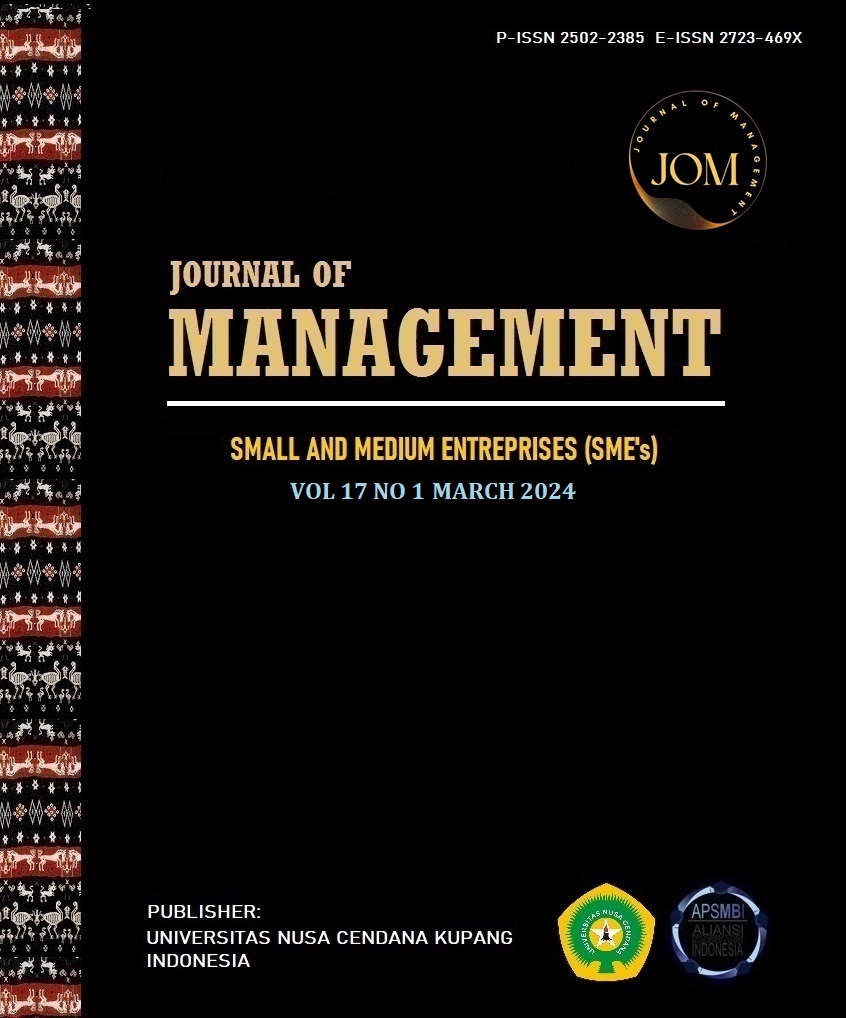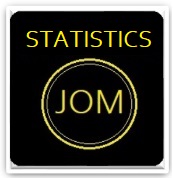TRANSFORMASI INOVASI MODEL BISNIS PADA UMKM BATIK PASCA PANDEMI COVID 19
Abstract
The pandemic phenomenon had a significant impact on small and medium-sized enterprises, compelling them to respond to the situation. Business Model Innovation (BMI) represents an innovation model suitable for the sustainability of small and medium-sized enterprises, particularly as the local SME situation deteriorated during the first two years of the COVID-19 pandemic, specifically in 2020-2021. The reconfiguration of business models has emerged as one of the alternatives for SMEs to overcome these challenges. The business model concept enables Small and Medium Enterprises (SMEs) to tackle dynamic business challenges. In reality, the alteration of Business Models (BMs) in SMEs varies across different organizations. This research aims to provide insights into the changes in BMs for SMEs following the pandemic, specifically within the batik industry, through the Integrated Marketing Communications (IMC) approach applied to various case studies. The method used in this research is descriptive qualitative through case studies with case selection using a purposive sampling approach, which is the MSME of the Batik Industry. The results of this study offer empirical information about the Business Model Innovation (BMI) of SMEs during the pandemic, which can serve as a foundation for further research in BMI, particularly concerning SMEs.
Keywords: Business Model Innovation; SMEs; Batik; Pandemic
Downloads
References
Campbell, C. (2008). Book review: Foucault, psychology and the analytics of power by Hook, Derek. Basingstoke: Palgrave MacMillan, 2007. 16(December 2008), 1–16. https://doi.org/10.1002/casp
Chesbrough, H. (2010). "Business Model Innovation: Opportunities and Barriers." Long Range Planning, 43(2–3), 354–363.
Chuang, S. H., & Lin, H. N. (2017). Performance implications of information-value offering in e-service systems: Examining the resource-based perspective and innovation strategy. Journal of Strategic Information Systems, 26(1), 22–38. https://doi.org/10.1016/j.jsis.2016.09.001
Coomes, O. T., Takasaki, Y., Abizaid, C., & Arroyo-Mora, J. P. (2016). Environmental and market determinants of economic orientation among rain forest communities: Evidence from a large-scale survey in western Amazonia. Ecological Economics, 129, 260–271. https://doi.org/10.1016/j.ecolecon.2016.06.001
Creswell, J. W., & Creswell, J. D. (2017). Research design: Qualitative, quantitative, and mixed methods approaches (4th ed.). Thousand Oaks, CA: Sage Publications.
Eastwood, J. G., Jalaludin, B. B., & Kemp, L. A. (2014). Realist explanatory theory building method for social epidemiology:A protocol for a mixed method multilevel study of neighbourhood context and postnatal depression. SpringerPlus, 3(1), 1–12. https://doi.org/10.1186/2193-1801-3-12
Fellnhofer, K. (2017). Drivers of innovation success in sustainable businesses. Journal of Cleaner Production, 167, 1534–1545. https://doi.org/10.1016/j.jclepro.2017.08.197
Folkeringa, M., Meijaard, J., & ... (2004). Strategic renewal and its effect on small firm performance. Testing for firm size and firm age effects using Dutch micro data. January 2004.
García-Gutiérrez, I., & Martínez-Borreguero, F. J. (2016). The innovation pivot framework: Fostering business model innovation in startups. Research Technology Management, 59(5), 48–56. https://doi.org/10.1080/08956308.2016.1208043
Gebauer, H., Saul, C. J., Haldimann, M., & Gustafsson, A. (2017). Organizational capabilities for pay-per-use services in product-oriented companies. International Journal of Production Economics, 192, 157–168. https://doi.org/10.1016/j.ijpe.2016.12.007
Ibarra, D., Bigdeli, A. Z., Igartua, J. I., & Ganzarain, J. (2020). Business model innovation in established SMEs: A configurational approach. Journal of Open Innovation: Technology, Market, and Complexity, 6(3). https://doi.org/10.3390/JOITMC6030076
Iñigo, E. A., & Albareda, L. (2016). Understanding sustainable innovation as a complex adaptive system: A systemic approach to the firm. Journal of Cleaner Production, 126, 1–20. https://doi.org/10.1016/j.jclepro.2016.03.036
KPAII. (2022). Rencana Kinerja Ditjen KPAII 2023 (p. 34). https://kpaii.kemenperin.go.id/documents/renkin-ditjen-kpaii-2023-Teq.pdf
Lessing, J., & Brege, S. (2015). Business models for product-oriented house-building companies - experience from two Swedish case studies. Construction Innovation, 15(4), 449–472. https://doi.org/10.1108/CI-02-2015-0009
Limanseto, H. (2022). No Title. Perkembangan UMKM Sebagai Critical Engine Perekonomian Nasional Terus Mendapatkan Dukungan Pemerintah. https://www.ekon.go.id/publikasi/detail/4593/perkembangan-umkm-sebagai-critical-engine-perekonomian-nasional-terus-mendapatkan-dukungan-pemerintah
Matzler, K., Bailom, F., von den Eichen, S. F., & Kohler, T. (2013). Business model innovation: Coffee triumphs for Nespresso. Journal of Business Strategy, 34(2), 30–37. https://doi.org/10.1108/02756661311310431
Newman, A., Prajogo, D., & Atherton, A. (2016). The influence of market orientation on innovation strategies. Journal of Service Theory and Practice, 26(1), 72–90. https://doi.org/10.1108/JSTP-02-2015-0044
Nurainun, Rasyimah, & Heriyana. (2019). Analisis Industri Batik Di Indonesia Oleh: Nurainun, Heriyana dan Rasyimah Fakultas Ekonomi Universitas Malikussaleh Banda Aceh. Fokus Ekonomi, 7(3), 124–135.
Purusottama, A., Ardianto, A., & Kadarusman, Y. B. (2022). A Different Magnitude of SME Business Model Innovation: A Lesson From The Pandemic. Indonesian Journal of Business and Entrepreneurship, 8(2), 182–194.
https://doi.org/10.17358/ijbe.8.2.182
Ramdani, B., Binsaif, A., & Boukrami, E. (2019). Business model innovation: a review and research agenda. New England Journal of Entrepreneurship, 22(2), 89–108. https://doi.org/10.1108/NEJE-06-2019-0030
Snihur, Y., & Wiklund, J. (2019). Searching for innovation: Product, process, and business model innovations and search behavior in established firms. Long Range Planning, 52(3), 305–325. https://doi.org/10.1016/j.lrp.2018.05.003
Spieth, P., & Meissner Née Schuchert, S. (2018). Business model innovation alliances: How to open business models for cooperation. International Journal of Innovation Management, 22(4), 1–26. https://doi.org/10.1142/S1363919618500421
Spieth, P., & Schneider, S. (2016). Business model innovativeness: designing a formative measure for business model innovation. Journal of Business Economics, 86(6), 671–696. https://doi.org/10.1007/s11573-015-0794-0
Swasty, W. (2015). Business Model Innovation for Small Medium Enterprises. The Winners, 16(2), 85. https://doi.org/10.21512/tw.v16i2.1561
Wahyono, & Hutahayan, B. (2021). The relationships between market orientation, learning orientation, financial literacy, on the knowledge competence, innovation, and performance of small and medium textile industries in Java and Bali. Asia Pacific Management Review, 26(1), 39–46. https://doi.org/10.1016/j.apmrv.2020.07.001
Westerlund, M. (2020). Digitalization, internationalization and scaling of online SMEs. Technology Innovation Management Review, 10(4), 48–57. https://doi.org/10.22215/TIMREVIEW/1346
York, J. M. (2020). Entrepreneurship & Organization Management The Role of the Business Model and Business Model Innovation as Essential Components to Commercialization, Entrepreneurship, and Strategic Renewal Keywords: Business model • Business model assessment • Business m. 9. https://doi.org/10.37421/jeom.2020.9.282
Yang, D., Wei, Z., Shi, H., & Zhao, J. (2020). Market orientation, strategic flexibility and business model innovation. Journal of Business and Industrial Marketing, 35(4), 771–784. https://doi.org/10.1108/JBIM-12-2018-0372

 Ratih Mukti Azhar(1*)
Ratih Mukti Azhar(1*)



